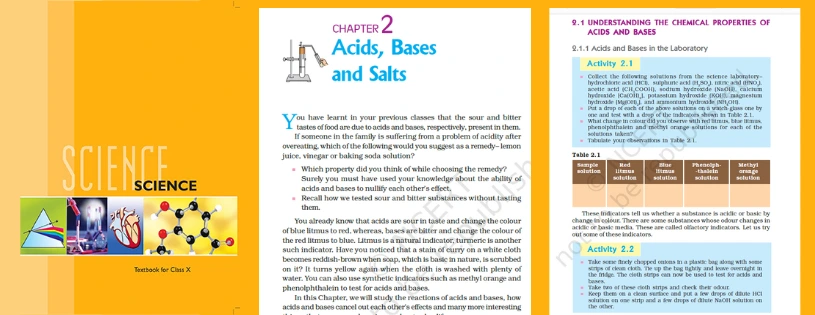The study of acids, bases, and salts is not merely a theoretical pursuit; it's a gateway to understanding the very nature of substances and their interactions. From the sour taste of lemons to the cleansing power of household detergents, the concepts we are about to explore have a direct impact on our daily lives.
Unlocking Chemistry Brilliance: CBSE NCERT Download for Acids, Bases, and Salts
The Basics: What Are Acids and Bases?
Acids:
Acids are substances that can release hydrogen ions (H+) when dissolved in water. They are often characterized by a sour taste and can turn blue litmus paper red. Common examples of acids include citric acid in lemons and hydrochloric acid in our stomachs.
Bases:
On the other hand, bases are substances that can release hydroxide ions (OH-) when dissolved in water. They usually have a bitter taste and feel slippery. Bases turn red litmus paper blue. A classic example of a base is sodium hydroxide (NaOH), also known as caustic soda.
The pH Scale: Measuring Acidity and Alkalinity
The pH scale is a numerical scale ranging from 0 to 14, used to measure the acidity or alkalinity of a solution. A pH of 7 is considered neutral, while values below 7 indicate acidity and values above 7 indicate alkalinity. It's like a chemical Richter scale for the strength of acids and bases.
- Acidic solutions: pH less than 7
- Neutral solutions: pH equals 7
- Alkaline (basic) solutions: pH greater than 7
Real-life Applications: Acids and Bases in Action
Acids:
- Digestion: Our stomach contains hydrochloric acid, aiding in the digestion of food.
- Cleaning Agents: Acids are often used in cleaning products to break down stains and grime.
Bases:
- Household Cleaners: Ammonia, a common base, is found in many household cleaning products.
- Antacids: Bases are used to neutralize excess stomach acid, providing relief from acidity.
Salts: The Result of Acid-Base Reactions
When an acid reacts with a base, they neutralizes each other, forming water and a salt. Salts are compounds composed of positive and negative ions. For example, the reaction between hydrochloric acid (HCl) and sodium hydroxide (NaOH) produces water (H₂O) and sodium chloride (NaCl), which is a common table salt.

Acid-Base Reactions
A neutralisation reaction occurs when an acid reacts with a base. Salt and water are the end products of this reaction. An acid–base neutralisation reaction is formulated as a double-replacement reaction in this standard approach.
Reactions of Acids and Bases
a) Reaction of acids and bases with metals
Acids, in general, react with metals to produce salt and hydrogen gas. Bases, in general, do not react with metals and do not produce hydrogen gas.
Acid + active metal → salt + hydrogen + heat
2HCl + Mg → MgCl2 + H2 (↑)
Hydrochloric acid + Magnesium → Magnesium chloride + Hydrogen
Base + metal → salt + hydrogen + heat
2NaOH + Zn → Na2ZnO2 + H2 (↑)
Sodium hydroxide + Zinc → Sodium zincate + Hydrogen
A more reactive metal displaces the less reactive metal from its base.
2Na + Mg (OH) 2 → 2NaOH + Mg
Sodium + Magnesium hydroxide → Sodium hydroxide + Magnesium
CBSE Class 10 NCERT Science Topics for a Strong Foundation (NCERT DOWNLOAD)
| Chapter Name | Acids, Bases and Salts |
| Topic Number | Topics |
| 2.1 | Definition in Terms of Furnishing of H+ and OH- ions |
| 2.2 | General Properties |
| 2.3 | Examples and Uses |
| 2.4 | Concept of pH Scale |
| 2.5 | Properties and Uses of Sodium Hydroxide |
b) Reaction of acids with metal carbonates and bicarbonates
Acids produce carbon dioxide, as well as metal salts and water, when they react with metal carbonates or metal bicarbonates. Sodium chloride, carbon dioxide, and water are formed when sodium carbonate interacts with hydrochloric acid. Allowing carbon dioxide gas to travel through lime water turns it milky.
Acid + metal carbonate or bicarbonate → salt + water + carbon dioxide.
2HCl + CaCO3 → CaCl2 + H2O + CO2
H2SO4 + Mg (HCO3)2 → MgSO4 + 2H2O + 2CO2
Effervescence indicates the liberation of CO2 gas.
c) Reaction of Acid with Base
1. Reaction of metal oxides and hydroxides with acids
Metal oxides or metal hydroxides are basic in nature.
Acid + base → salt + water + heat
H2SO4 + MgO → MgSO4 + H2O
2HCl + Mg (OH) 2 → MgCl2 + 2H2O
2. Reaction of non-metal oxides with bases
Non-metal oxides are acidic in nature
Base + Nonmetal oxide → salt + water + heat
2NaOH + CO2→ Na2CO3 + H2O
CBSE Class 10 Board Exam Sample Paper

[Previous Year Question Solution Maths Download Button]
[Previous Year Question Solution Science Download Button]
| CBSE CLASS 10 Mathematics Chapters |
| Chapter1: Real Numbers |
| Chapter2: Polynomials |
| Chapter3: Pair of Linear Equations in Two Variables |
| Chapter4: Quadratic Equations |
| Chapter5: Arithmetic Progressions |
| Chapter6: Triangles |
| Chapter7: Coordinate Geometry |
| Chapter8: Introduction to Trigonometry |
| Chapter9: Some Applications of Trigonometry |
| Chapter10: Circles |
| Chapter11: Areas Related to Circles |
| Chapter12: Surface Areas and Volumes |
| Chapter13: Statistics |
| Chapter14: Probability |
| CBSE CLASS 10 Science Chapters |
| Chapter1: Chemical Reactions and Equations |
| Chapter2: Acids, Bases and Salts |
| Chapter3: Metals and Non-metals |
| Chapter4: Carbon and its Compounds |
| Chapter5: Life Processes |
| Chapter6: Control and Coordination |
| Chapter7: How do Organisms Reproduce? |
| Chapter8: Heredity |
| Chapter9: Light – Reflection and Refraction |
| Chapter10: The Human Eye and the Colourful World |
| Chapter11: Electricity |
| Chapter12: Magnetic Effects of Electric Current |
| Chapter13: Our Environment |
| Class 8 |
| Class 9 |
| Class 11 |
| Class 12 |
CBSE Class 10th Downloadable Resources:
| 1. CBSE Class 10th Topic Wise Summary | View Page / Download |
| 2. CBSE Class 10th NCERT Books | View Page / Download |
| 3. CBSE Class 10th NCERT Solutions | View Page / Download |
| 4. CBSE Class 10th Exemplar | View Page / Download |
| 5. CBSE Class 10th Previous Year Papers | View Page / Download |
| 6. CBSE Class 10th Sample Papers | View Page / Download |
| 7. CBSE Class 10th Question Bank | View Page / Download |
| 8. CBSE Class 10th Topic Wise Revision Notes | View Page / Download |
| 9. CBSE Class 10th Last Minutes Preparation Resources (LMP) | View Page / Download |
| 10. CBSE Class 10th Best Reference Books | View Page / Download |
| 11. CBSE Class 10th Formula Booklet | View Page / Download |
Being in CBSE class 10th and considering the board examinations you must be needing resources to excel in your examinations. At TestprepKart we take great pride in providing CBSE class 10th all study resources in downloadable form for you to keep you going.
Below is the list of all CBSE class 10th Downloads available on TestprepKart for both Indian and NRI students preparing for CBSE class 10th in UAE, Oman, Qatar, Kuwait & Bahrain.
FAQ
Q:1 What is the definition of an acid?
Ans: An acid is a substance that can donate a proton (H+) or accept an electron pair in a chemical reaction.
Q:2 Provide an example of a strong acid.
Ans: Hydrochloric acid (HCl) is an example of a strong acid.
Q:3 How are acids classified based on their ionization in water?
Ans: Acids are classified as strong acids if they completely ionize in water and weak acids if they only partially ionize.
Q:4 What is the pH scale, and what does it measure?
Ans: The pH scale measures the acidity or basicity of a solution, ranging from 0 (most acidic) to 14 (most basic), with 7 being neutral.
Q:5 What is the difference between a strong acid and a weak acid?
Ans: A strong acid completely ionizes in water, while a weak acid only partially ionizes.
Leave a Reply